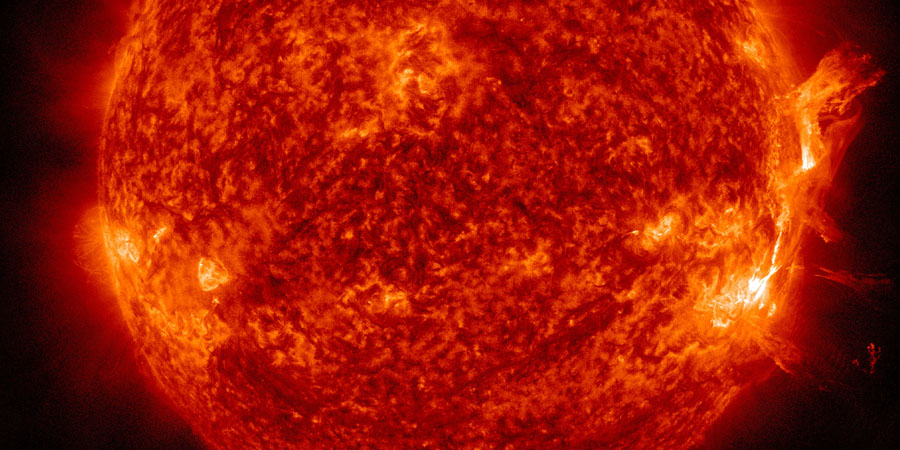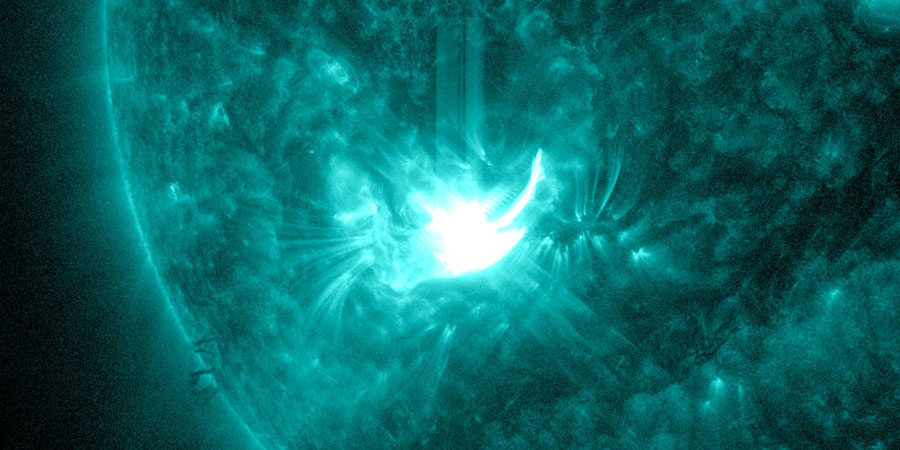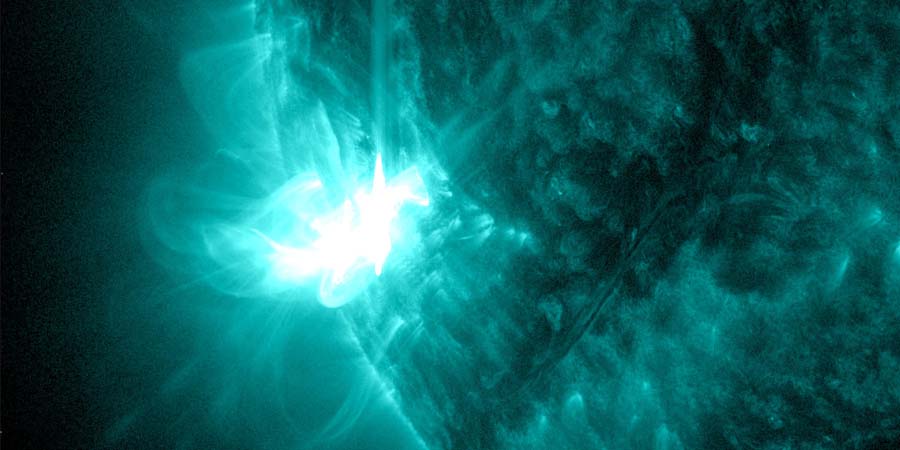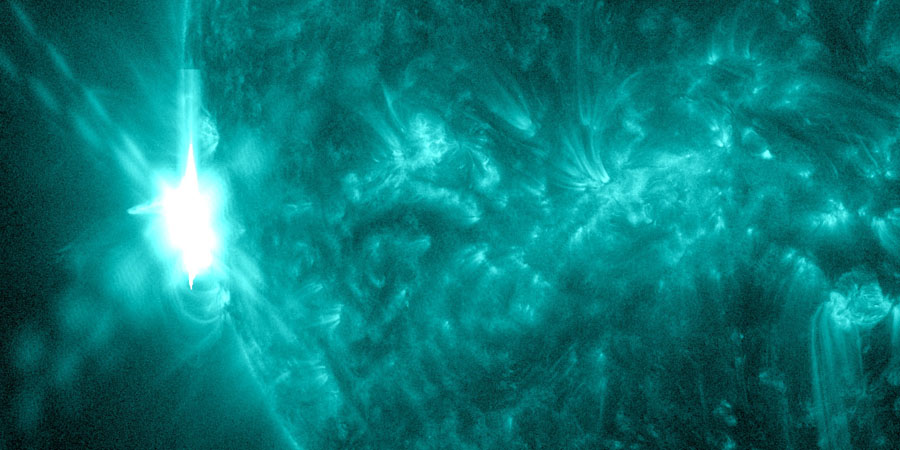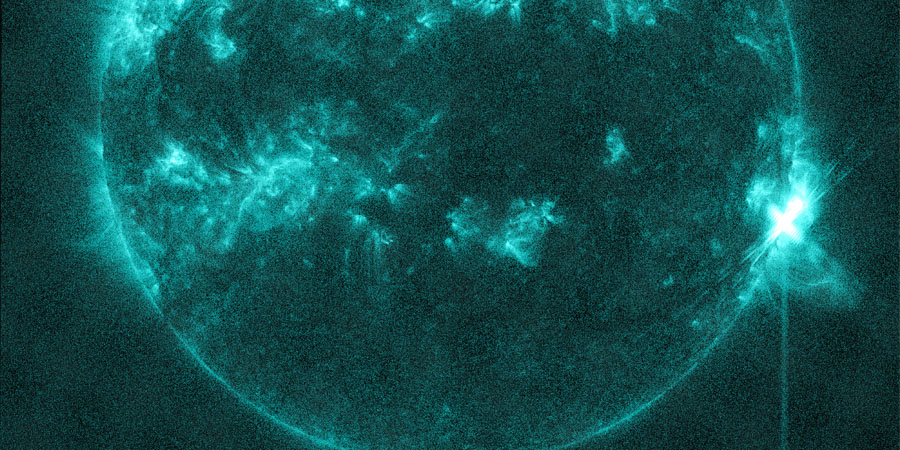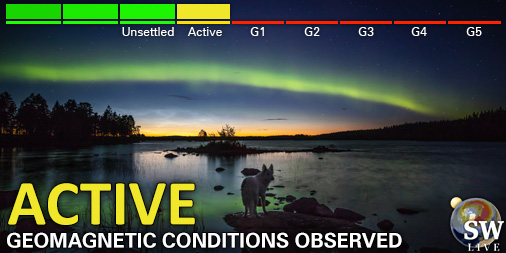Latest news updates Subscribe
M9.3 solar flare, S3 proton storm, Earth-directed CME
sobota, 8 czerwca 2024 15:29 UTC
Sunspot region 3697 has been relatively quiet the past few days as she made her way towards the west limb but she was not planning to exit stage right without one final song. At 01:49 UTC this night the region produced a highly eruptive long duration M9.7 (R2-moderate) solar flare.
Double impulsive X-class flares
sobota, 1 czerwca 2024 15:48 UTC
Two X-class solar flares (X1.1 and X1.3) took place during the past 24 hours peaking at 22:03 UTC (31 May) and 08:48 UTC (1 June). These were impulsive events which originated from sunspot region 3697. Both of these events were not eruptive and did not launch coronal mass ejections.
X1.4 solar flare from sunspot region 3697
środa, 29 maja 2024 19:13 UTC
Ex-3664 which is now numbered as sunspot region 3697 is at it again this time with a long duration X1.4 solar flare (R3-strong) that peaked at 14:37 UTC.
X2.9 solar flare, Welcome back 3664?
poniedziałek, 27 maja 2024 17:22 UTC
A major X2.9 solar flare (R3-strong) took place today peaking at 07:08 UTC. The flare came from a sunspot region just behind the south-east limb. This is likely the anticipated return of old sunspot region 3664 which was the source of many major X-class solar flares during its previous visit of the earth-facing solar disk and an extreme G5 geomagnetic storm which was the first of its kind in 21 years.
Let's compare! Halloween 2003 VS May 2024 Solar Storms!
piątek, 17 maja 2024 18:33 UTC
Today we have a really special news item for you! We have a guest post made by Christian Harris from Space Weather Trackers. Christian is a friend of the website an has made very well received guest posts before. He has some serious big brain knowledge about everything space weather related. I am sure many of you have heard of him before. He is here to shed some light on the Extreme G5 geomagnetic storm of last weekend and the famous Halloween 2003 solar storms. Please read his article below and gain some fascinating insights on two of the strongest solar storms in modern times. It is well worth the read! If you are interested in Christian's work be sure to follow him on Facebook and follow his Space Weather Trackers Facebook page. Christian, the stage is yours:
Coronal mass ejection impact, New website feature!
piątek, 17 maja 2024 17:03 UTC
A coronal mass ejection impact was detected at DSCOVR around 12:40 UTC today. The north-south direction of the interplanetary magnetic field (Bz) flipped southward to about -12nT to -12nT. A minor G1 geomagnetic storm watch is in effect for the remainder of the day.
More X-flares!
środa, 15 maja 2024 18:40 UTC
Sunspot region 3664 continues producing major solar flares even now that it rotated behind the west limb. An X3.4 solar flare that peaked at 08:37 UTC was highly eruptive and an impressive coronal mass ejection could be seen on LASCO coronagraph imagery from SOHO. The coronal mass ejection is however, as you might have guessed already, not aimed at our planet.
X8.7 solar flare
wtorek, 14 maja 2024 19:42 UTC
What a way to sign off! Sunspot region 3664 (R3-strong) is now on the west limb and waves goodbye by producing the largest solar flare of Solar Cycle 25 which peaked at X8.7! Wow! There isn't any coronagraph imagery available from SOHO yet, but we do know the solar flare was eruptive but based on coronagraph imagery from STEREO A, the resulting coronal mass ejection is likely not aimed at Earth.
M6.6 solar flare with earth-directed CME
poniedziałek, 13 maja 2024 18:46 UTC
Sunspot region 3664 is now close to the west limb and quieted down a bit compared to last week. Nonetheless it was the source of an eruptive long duration M6.6 solar flare (R2-moderate) that peaked at 9:44 UTC.
Small CME impact, Record visitor amount
niedziela, 12 maja 2024 10:12 UTC
Geomagnetic conditions have subsided considerably since the intense storm conditions during 10 and 11 May. Storm conditions that several times reached the Extreme G5 geomagnetic storm threshold and rivaled the 2003 Halloween Solar Storms.
Najnowsze wiadomości
Najnowsze wiadomości z forum
Wesprzyj SpaceWeatherLive.com!
Wielu ludzi odwiedza SpaceWeatherLive aby śledzić aktywność słoneczną lub sprawdzić czy jest szansa na zaobserwowanie zorzy polarnej. Niestety, większy ruch na stronie oznacza większe koszty utrzymania serwera. Dlatego, jeśli jesteś zadowolony ze strony SpaceWeatherLive, zachęcamy do wspierania nas finansowo. Dzięki temu będziemy mogli utrzymać naszą stronę.

Alerty
04:15 UTC - Aktywność geomagnetyczna
Aktywne warunki geomagnetyczne (Kp4) Osiągnięty próg: 03:57 UTC
02:30 UTC - Indeks mocy półkuli
Model OVATION przewiduje, że index mocy półkuli osiągnie 50GW o 03:23 UTC
środa, 16 kwietnia 2025
21:45 UTC - Aktywność geomagnetyczna
Słaba burza geomagnetyczna G1 (Kp5) osiągnięty próg: 21:36 UTC
21:00 UTC - Aktywność geomagnetyczna
Bardzo silna burza geomagnetyczna G4 (Kp8) osiągnięty próg: 20:55 UTC
19:45 UTC - Aktywność geomagnetyczna
Silna burza geomagnetyczna G3 (Kp7) Osiągnięto próg: 19:25 UTC
Fakty na temat pogody kosmicznej
| Ostatnie rozbłyski klasy X | 2025/03/28 | X1.1 |
| Ostatnie rozbłyski klasy M | 2025/04/15 | M1.2 |
| Ostatnia burza geomagnetyczna | 2025/04/16 | Kp8- (G4) |
| Dni bez plam słonecznych | |
|---|---|
| Ostatni dzień bez skazy | 2022/06/08 |
| Średnia miesięczna liczba plam słonecznych | |
|---|---|
| marca 2025 | 134.2 -20.4 |
| kwietnia 2025 | 120.5 -13.7 |
| Ostatnie 30 dni | 118.3 -22.1 |
